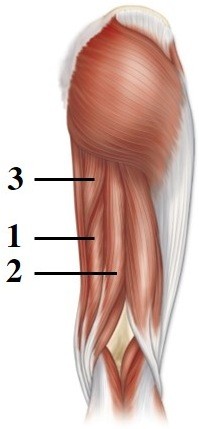 This figure shows a posterior view of the right thigh. What muscle does number 3 indicate?
This figure shows a posterior view of the right thigh. What muscle does number 3 indicate?
A. Semitendinosus
B. Adductor magnus
C. Gluteus maximus
D. Semimembranosus
E. Biceps femoris
Answer: B
You might also like to view...
The known functions of the sympathetic innervation of the kidneys include
A) direct stimulation of water reabsorption. B) regulation of the glomerular blood flow. C) stimulation of renin release. D) direct stimulation of sodium ion reabsorption. E) All of the answers are correct.
Which of the following statements regarding the muscularis externa of the esophagus is true?
A) The upper third portion of the esophagus consists of smooth muscle, the middle third portion is a mixture of smooth and skeletal muscles, and the lower third consists of skeletal muscle. B) The entire muscularis of the esophagus consists of skeletal muscle only. C) The entire muscularis of the esophagus consists of smooth muscle only. D) The upper third portion of the esophagus consists of smooth muscle, and the remaining portion is a mixture of skeletal and smooth muscles. E) The upper third portion of the esophagus consists of skeletal muscle, the middle third portion is a mixture of skeletal and smooth muscles, and the lower third consists of smooth muscle.
The visual cortex on the right side receives information from the lateral side of the right eye and the media side of the left eye
Indicate whether the statement is true or false
Which of the following statements regarding the hangman's fracture is correct?
A) Hangman's fractures occur when the patient's skull rapidly accelerates. B) Most hangman's fractures occur during a fall from greater than 10 feet. C) It is a fracture of C2 that is secondary to significant distraction of the neck. D) Severe hyperflexion of the neck commonly results in a hangman's fracture.